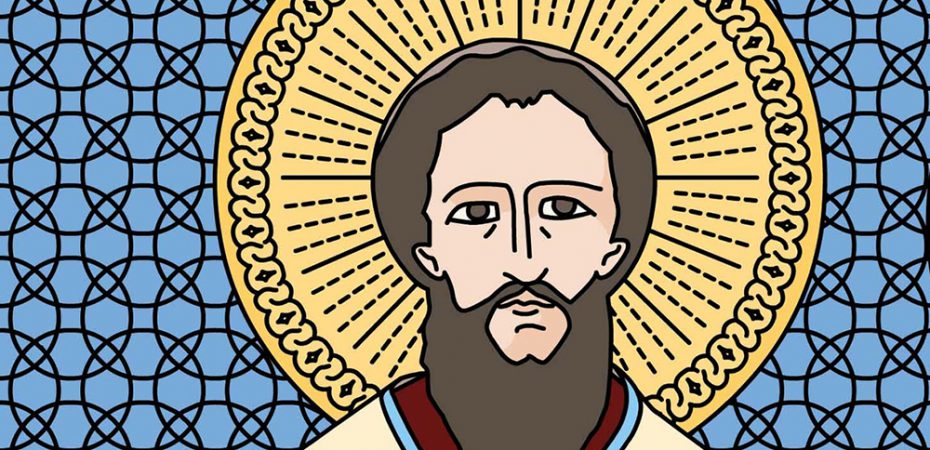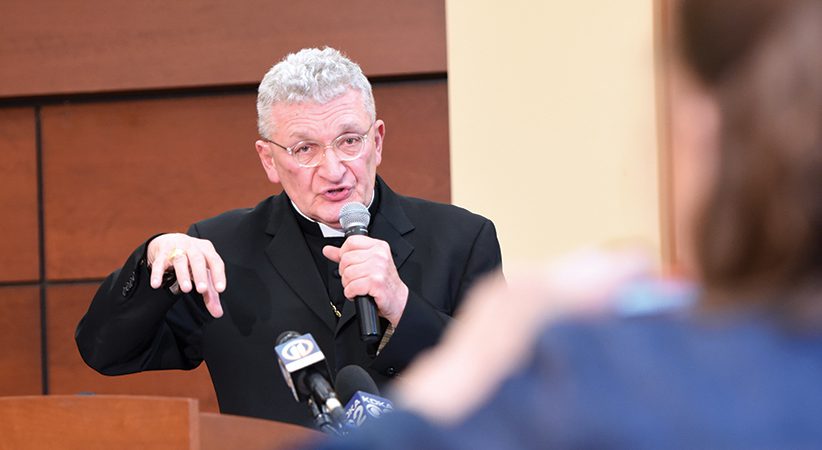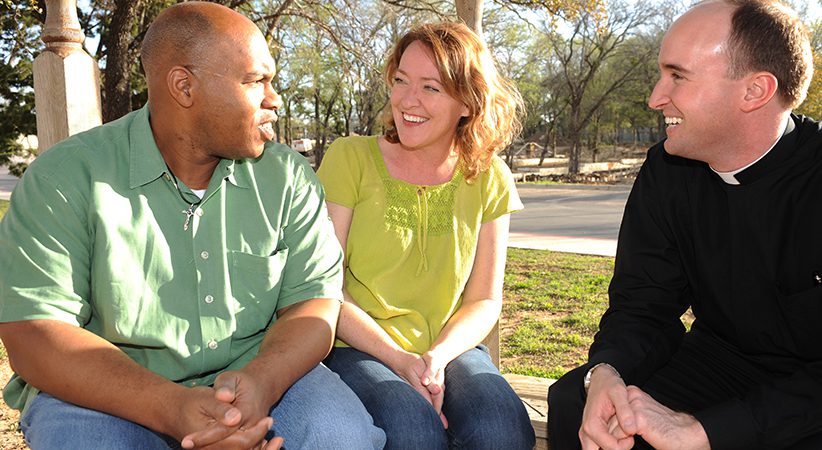The lapsed controversy and Church teaching
What can be learned from St. Cyprian, bishop and martyr
D.D. Emmons Comments Off on The lapsed controversy and Church teaching
We often fail to appreciate how our Catholic teachings have developed over the centuries; the beliefs we take for granted, issues long ago resolved, were in many cases very complex and controversial when they initially surfaced. Such was the case in the third and fourth centuries, parts of which can only be described as tumultuous times to be a Christian.
These were eras when the Roman emperors inflicted extreme persecutions on the followers of Christ. The way the fledgling Church and the faithful responded to these persecutions would have a major impact on what we believe about the Church’s role in the forgiveness of sins, about reconciliation and baptism.
Roman Persecutions
Among the most notorious in his methods was Emperor Decius (r. 249-51). When Decius came to power in 249, cracks were beginning to show in the fiber of the Roman Empire: invasion by barbarians, economic crises, poor government policies and internal division, all contributed to a weakened state. Decius concluded that many people under Roman rule were neglecting not only sincere worship of the Roman gods but the divinity of the emperor. He believed this was contributing to the empire’s widespread problems. Among the scapegoats Decius sought, Christians were easy targets. According to the emperor, even natural disasters were caused by Christians who focused on one God and refused to worship the many pagan gods of the Romans. The great Tertullian (155-220) of Carthage had written decades before about this Roman blame game: “If the Tiber rises to the city walls, if the Nile does not rise to the fields, if the weather continues without change, if there is an earthquake, if famine, if pestilence, immediately, ‘Christians to the lion! So many for one beast’” (“Apology”).
Emperor Decius’ solution was to mandate that every person, under the threat of persecution, make an oath, a sacrifice, to the Roman pagan gods and acknowledge the deity of the emperor. In return, they would be given a certificate, known as a libellus, indicating that the individual had made the sacrifice and thus would avoid persecution. Anyone who refused was subject to being tortured and jailed with the expectation that they would be put to death.
Lapsed Christians
Indeed, hundreds of Christians were imprisoned because they refused to comply with the edict, refusing to deny Jesus. These pious individuals gave credence to the words of Our Savior: “But whoever denies me before others, I will deny before my heavenly Father” (Mt 10:33). There were other Christians in large numbers who submitted to worship the pagan gods as well as Caesar and, at least in public, renounced their faith to avoid arrest, jail and worse. Most Christians that acquiesced to the Roman law did so by making an act of sacrifice or worship before a pagan statue. Some, instead of an act of worship, bribed Roman officials and obtained the certificate, which indicated that the person had complied with the Roman mandate.
Considered as traitors, they were excommunicated by the Church even though, in some instances, the sincerity of their oath-taking and worship may have been feigned. The Christians who chose to deny Christ in the face of persecution would become known as the lapsed, or lapsi — that is, they allowed their faith to lapse, fallen away.
Emperor Decius was killed during a military campaign in 251, and the persecutions soon ended. Numerous of the lapsed now wanted to renew their relationship with the Christian faith. This led to a dilemma in the Church: Could these people, these lapsi, be accepted back? Could they be forgiven for the grave sin of denying Christ and, if so, under what conditions?
Bishop of Carthage

Cyprian (c. 210-58) converted to Christianity at age 46 and, after only two years as a Christian, was elected as bishop of Carthage where he reigned until his death. As the Decian persecution began, Cyprian hid in a cave and stayed in touch with his flock through letters encouraging them to maintain their faith and prayers. He encouraged them that God would deliver every Christian from the hands of his enemies. Criticized for what some considered a cowardly act, Cyprian believed he would have been imprisoned by the Romans, as were many bishops, and hence would not have been able to serve the Christians within his domain.
When the persecutions ended, he resumed his role as bishop and disagreed with the position that Novatian — a self-proclaimed spokesman for the Church who claimed to be bishop of Rome — and others were advocating about the lapsi. Cyprian instead supported the actions of Cornelius, bishop of Rome, who claimed the lapsed could return. The lapsed person could rejoin the Church, but only with the approval of his bishop, who would decide about confession and level of penance. A rift soon developed, with Cyprian and Cornelius (r. 251-53) on one hand and Novatian on the other.
Cyprian made no distinction between the lapsi who had chosen to worship a Roman god and those who bought a certificate. Writing that “God cannot be mocked” (“The Lapsed”), he addressed those who believed they had done less wrong because they had obtained a certificate through bribery: “Nor let those persons flatter themselves that they need repent less, who, although they have not polluted their hands with abominable sacrifices, yet have defiled their conscience with certificates” (ibid). The lapsed might be readmitted to the Church, but only under the conditions as described by Cyprian and Cornelius.
Complicating this issue were the Christians that had been jailed for their refusal to worship the pagan gods. Called confessors, they wanted to assist their lapsed brethren by providing letters or certificates to the proper bishop pleading that their time in jail, and their likely martyrdom, was being offered on behalf of one of the lapsed Christians who was seeking to return to the Church. Cyprian’s position was that no matter the good intentions of the confessors, the lapsed seeking a return to the Church had to be approved by the bishop, which meant confession and completion of, in most instances, an arduous and lengthy penance. He wrote to the confessors saying that the lapsed had acted “contrary to the law of the Gospel, contrary even to your respectful petition, before penance has been done, before a confession of the most grave and extremist sin has been made, before a hand has been imposed in penance by the bishop and the clergy — to offer on their behalf and give them the Eucharist; that is to profane the holy Body and Blood of the Lord” (“Letter to Certain Martyrs and Confessors”).
For all this, and indifference to the Novatians preaching that only God could forgive mortal sin, the lapsi controversy established that there is no sin that the Church cannot forgive.
One Baptism
During the debate about the lapsi, certain bishops followed Novatian away from the Church in disagreement with the position on reconciliation. These bishops not only ordained individuals into the priesthood but baptized many converts. Later some converts wanted to join the universal Church rather than remain outside the fold. Cyprian claimed that the bishops who separated from the Church were heretics and, as such, no longer possessed the gifts of the Holy Spirit; thus the individuals they converted had to be baptized again before being considered Christians. Cyprian said, “How can he who lacks the Spirit confirm the Spirit?” They could not consecrate the baptismal water or the holy chrism, thus could not baptize.
Cyprian’s disfavor of a baptism conducted by a heretic follows that of St. Tertullian, who had advocated that while there was only one baptism, that baptism had to be administered by the true Church. This thinking did not distinguish between what was lawful and what was valid; the erroneous conclusion was that if it was unlawful, it could not be valid.
During three third-century councils in Carthage, the African bishops unanimously agreed with the position Cyprian held. In Rome, the bishop at the time was St. Stephen I (r. 254-57), and he had a significantly differing opinion, an opposite view about the efficaciousness of the heretical baptisms. He said, “The minister of baptism performs the act, but God gives the grace.” He went on to say that as long as the person is baptized with the Trinity formula, the baptism is valid.
Stephen decreed, “Let nothing be changed, but let the ancient tradition be maintained.” Simply, those baptized by the heretical bishops, assuming the correct rite was used, could be received back into the Church by the laying on of hands. No one had to be re-baptized. To make his point, he threatened excommunication to any of the African bishops who taught otherwise. This issue was widely debated, but both Sts. Cyprian and Stephen would die for their faith before the issue was resolved. Every valid baptism is, of course, accepted by the Church as clarified at the Council of Arles in 314 and at the Council of Trent in the 16th century. The Arles council specifically addressed and rejected the African Church teaching on the need to re-baptize.
Cyprian’s Martyrdom
When Valerianus was Roman emperor (r. 253-60), he issued an edict that every member of the Christian clergy should make an oath to worship the Roman gods or face being murdered. Cyprian refused and, on Sept. 14, 258, was brought before a Roman proconsul for sentencing. The Roman official gave Cyprian the opportunity to make an allegiance, an act of worship to the Roman deity; Cyprian refused. The proconsul ordered that the accused be beheaded, “put to death by the sword.” Cyprian responded: “Thanks be to God.”
“When the sentence was passed … Cyprian was led out into the plain of Sextus, and there he took off his cloak and knelt down and bowed himself in prayer to God. And when he had taken off his dalmatic and given it to his deacons, he stood up in his linen under-garment and waited for the executioner. When he had come, Cyprian ordered his friends to give him [the executioner] twenty-five pieces of gold. Linen cloths and napkins were laid down before Cyprian by the brethren, and he bandaged his eyes with his own hands. … So suffered blessed Cyprian” (“Butler’s Lives of the Saints,” H Thurston, P.J. Kenedy and Sons, 1956).
D.D. EMMONS writes from Pennsylvania.
……………………………………………………………………………………………………………………………………………………
Bishops St. Fabian, St. Cornelius and Novatian
One of the first Christian martyrs under Decius’ edict was St. Fabian, the bishop of Rome who reigned 236-50. After his martyrdom and because of the persecutions, the selection of a new bishop was delayed for some 14 months. At that time, the title “pope” was not limited to the bishop of Rome; all bishops were elected locally and considered equal in stature with the exception that the Rome bishop traditionally held the most prestigious position. It was later, during the time of St. Gregory I the Great (r. 590-604), that the bishop of Rome took on the rule over the universal Church and the title “pope” applied to him alone.
St. Cornelius (r. 251-53) was eventually selected to succeed Fabian, but in the months during which the Rome episcopacy was vacant, a bishop named Novatian had become the self-proclaimed spokesman for the Church. Novatian expected that he would be acclaimed as bishop of Rome, but instead Cornelius was elected. Cornelius, who was later martyred, believed that after a reasonable time of penance, the lapsed could once again join in holy Communion.
Novatian vigorously rejected this idea. He held that there were no circumstances under which the lapsi, who had committed the grievous sin of apostasy, could rejoin the Church; only God could forgive such mortal sin. Novatian claimed for himself the bishop’s position in Rome, then broke from the Church and started his own church. Some clergy sided with Novatian, especially in Gaul and Spain, and he may have made a bigger impact except for a bishop in Africa named Thascius Caecilius Cyprianus, whom we know as Cyprian.
…………………………………………………………………………………………………………………………………………………….





